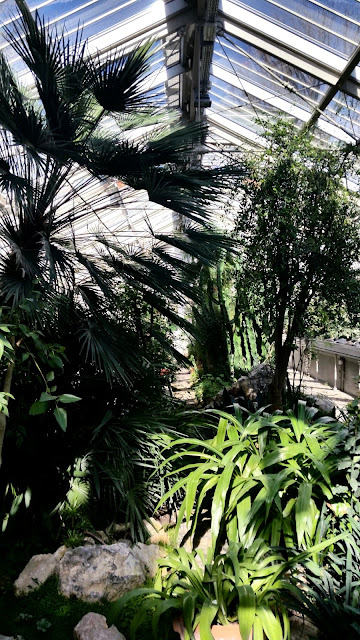After
enduring 4 months of Australian winter then followed by 6 months of European winter, I am
well and truly over cold weather, but today the sun came out and the
temperature catapulted up to 15 degrees, so I declared today – March 02 – the end of Winter
and the beginning of Spring for me ...
And to celebrate, I dedicated my day to flowers ...
First
up it was a morning caffeine shot at my favourite café which included a sprig
of wattle on the table – a very nostalgic token for this wanderer from Oz. ( For non-Australians … Golden Wattle ( Acacia
pycnantha ) is our national flower. The Wattles start blooming in spring down-under beginning in September … ). Here the plant is called Golden Mimosa, and sprigs of the flower are on sale on just about every street corner - bringing a hint of colour to the cold city.
After that, it was a short walk through the city centre to the Botanical Gardens for a peaceful wander around the still-sleeping arboretum. With only a few mums pushing their bubs around in strollers and the gardeners raking up leaves and no one else, the place was mine to sit in the warm sun and breathe in the freshly oxygenated air for a spell.
Situated in the centre of the noisy rushing city, the Jevremovac
Botanical Garden is the botanical garden of the University of Belgrade and is administered
by the University’s Biology School. It was founded in 1874 by the decree of the
Ministry of Education of the Kingdom of Serbia, at the suggestion of Josif
Pančić, a famous Serbian botanist who also became its first manager.
In
1889, King Milan Obrenović donated the estate ( inherited from his grandfather
Jevrem Obrenović ) to the Great School in Belgrade for the purpose of the
construction of a botanical garden, provided that it be named
"Jevremovac" (Serbian for "Jevrem's garden"), after his
grandfather.
After
World War II, the new Communist authorities suppressed public usage of the word
Jevremovac, so for several decades it was simply known as the "botanical garden" until the
1990s when Jevremovac came into common usage again.
The Gardens are spread over an area of 50,000 square metres of open space and include more than 500 species of trees and bushes from local, European and exotic regions – including species familiar from Australia and the Pacific region. Besides the open space, the arboretum also includes a greenhouse and the Institute of Botany's premises.
The greenhouse, built in 1892, covers an area of 500 m². At the time of its construction, it was one of the biggest and most beautiful greenhouses in this part of Eastern Europe.
Numerous tropical and sub-tropical plants are being nursed, including several species of palms, ferns and cactus – and even a very healthy Silky Oak tree from Australia . The greenhouse is protected by the law for its architectural values.
In a hidden corner of the arboretum is a Japanese garden created by Vera and Mihailo Grbic ( landscape
architects ) opened in May 2004. And it was very peaceful to sit there in the mottled warm sun listening to the comforting running water ...
Being the closing days of winter, there was not a lot of greenery nor many flowers in the Gardens, but
as a sign that the chills of winter are disappearing and the warmth of Spring
is just around the corner, is was good to see the new leaf buds on this Forsythia europaea ( a
Serbian local … ).
Then, fully
refreshed, showered and glammed-up in my good rags, it was off to the
rather grand National Theatre for a shot of culture … still on the flower theme
it was a great production of the ballet version of The Lady of the Camellias (
based on Alexandre Dumas novel of the same name – danced to the music from
Verdi’s opera La Traviata - this is a rather sad tale about love gone wrong
– poor courtesan Violetta who had a use for red and white Camellias that I wont go into here –
look it up on Wikipedia if you are curious to know the story … !!! …).
So
that was my celebration of the coming of an early Spring – hopefully on the
real first day of Spring – wherever I am – the sun will be even warmer and
the trees even greener and the flowers even bloomier …


























No comments:
Post a Comment
Note: Only a member of this blog may post a comment.